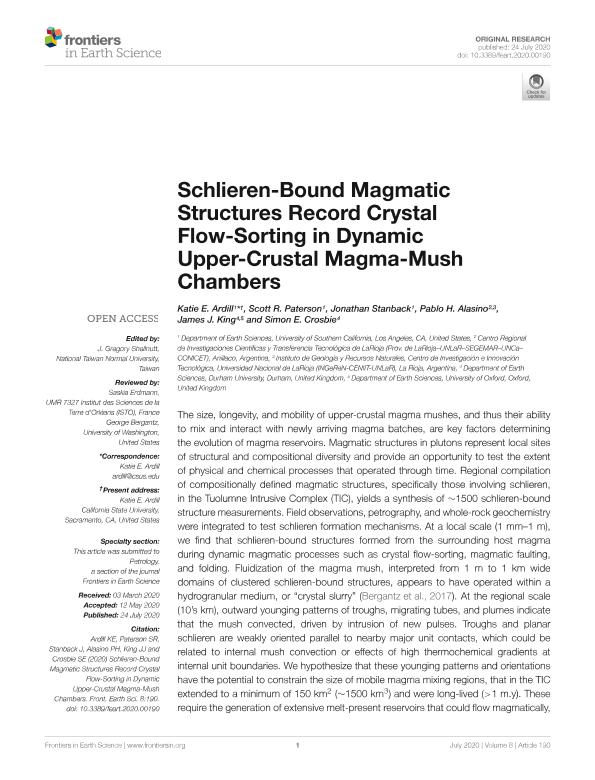Artículo
Schlieren bound magmatic structures record crystal flow sorting in dynamic upper crustal magma mush chambers
Ardill, Katie E.; Paterson, Scott Robert; Stanback, Jonathan; Alasino, Pablo Horacio ; King, James J.; Crosbie, Simon E.
; King, James J.; Crosbie, Simon E.
 ; King, James J.; Crosbie, Simon E.
; King, James J.; Crosbie, Simon E.
Fecha de publicación:
24/07/2020
Editorial:
Frontiers Media
Revista:
Frontiers in Earth Science
ISSN:
2296-6463
Idioma:
Inglés
Tipo de recurso:
Artículo publicado
Clasificación temática:
Resumen
The size, longevity, and mobility of upper-crustal magma mushes, and thus their ability to mix and interact with newly arriving magma batches, are key factors determining the evolution of magma reservoirs. Magmatic structures in plutons represent local sites of structural and compositional diversity and provide an opportunity to test the extent of physical and chemical processes that operated through time. Regional compilation of compositionally defined magmatic structures, specifically those involving schlieren, in the Tuolumne Intrusive Complex (TIC), yields a synthesis of ∼1500 schlieren-bound structure measurements. Field observations, petrography, and whole-rock geochemistry were integrated to test schlieren formation mechanisms. At a local scale (1 mm–1 m), we find that schlieren-bound structures formed from the surrounding host magma during dynamic magmatic processes such as crystal flow-sorting, magmatic faulting, and folding. Fluidization of the magma mush, interpreted from 1 m to 1 km wide domains of clustered schlieren-bound structures, appears to have operated within a hydrogranular medium, or “crystal slurry” (Bergantz et al., 2017). At the regional scale (10’s km), outward younging patterns of troughs, migrating tubes, and plumes indicate that the mush convected, driven by intrusion of new pulses. Troughs and planar schlieren are weakly oriented parallel to nearby major unit contacts, which could be related to internal mush convection or effects of high thermochemical gradients at internal unit boundaries. We hypothesize that these younging patterns and orientations have the potential to constrain the size of mobile magma mixing regions, that in the TIC extended to a minimum of 150 km2 (∼1500 km3) and were long-lived (>1 m.y). These require the generation of extensive melt-present reservoirs that could flow magmatically, formed from the amalgamation of intruding magma pulses, and precludes dike, sill, or laccolith emplacement models. We conclude that schlieren-bound structures are faithful recorders of the multi-scale, hypersolidus evolution of upper-crustal magma bodies, and represent useful tools for studying plutonic systems.
Archivos asociados
Licencia
Identificadores
Colecciones
Articulos(CRILAR)
Articulos de CENTRO REGIONAL DE INV. CIENTIFICAS Y TRANSFERENCIA TECNOLOGICA DE ANILLACO
Articulos de CENTRO REGIONAL DE INV. CIENTIFICAS Y TRANSFERENCIA TECNOLOGICA DE ANILLACO
Citación
Ardill, Katie E.; Paterson, Scott Robert; Stanback, Jonathan; Alasino, Pablo Horacio; King, James J.; et al.; Schlieren bound magmatic structures record crystal flow sorting in dynamic upper crustal magma mush chambers; Frontiers Media; Frontiers in Earth Science; 8; 190; 24-7-2020; 1-35
Compartir
Altmétricas



